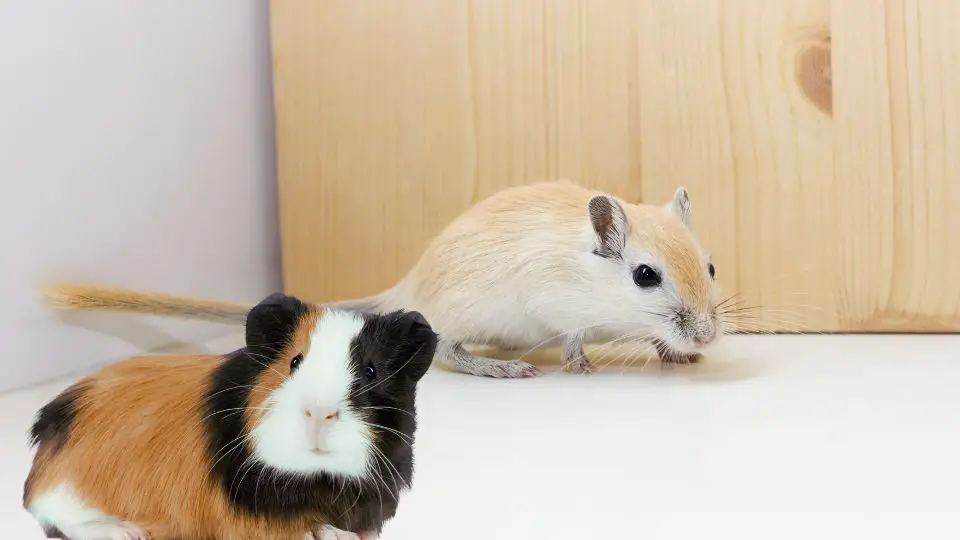Gerbils may not be as cuddly and furry as cats or dogs, but they have their own set of tricks which make them just as lovable. These small rodents may seem like an easy pet to care for, but they do require some special attention and affection.
Taming a gerbil to become a part of your family will not happen overnight, but with the right approach and some patience, it can be done. Spending time with your gerbil in a calm and quiet environment is key to getting your pet used to you. Let them get used to the sound of your voice and your smell. Start by simply talking to them in a soft, calm voice and offer them treats from your hand.
In this article, we’ll be taking you through the steps of taming a gerbil including how to build trust, pick up your pet, and create a safe environment.
Understanding Gerbil Behavior
Gerbils are small, active, and social animals that are known for their playful and curious nature. In the wild, gerbils live in large colonies and spend most of their time foraging for food, digging burrows, and interacting with their family and colony members.
When you try to tame your gerbil, you have to understand that wild and domestic gerbils have different behaviors. Wild gerbils are more skittish and may be harder to tame, while domestic gerbils have been bred in captivity and may be more used to human interaction.
We already want to mention that taming a gerbil can take time and patience. You must be consistent in your efforts and don’t force the gerbil to interact with you if it doesn’t want to.
You must understand the body language of your little pet before trying anything. Gerbils communicate with each other through a variety of vocalizations, such as chirps, whistles, and barks, as well as through body language.
Some signs that a gerbil is feeling stressed or threatened include puffing up their fur, flattening their ears, or freezing in place. On the other hand, a relaxed and comfortable gerbil may have a relaxed posture, wag its tail, or make soft vocalizations.
Do gerbils like to be touched?
Some gerbils may enjoy being petted and handling, while others may become fearful when touched. It’s best to let the gerbil come to you rather than forcing them into a situation they’re uncomfortable with.
Preparing for Taming
Before starting the taming process, there are some things that you should take into consideration.
Comfortable and safe space
Create a space that is comfortable for your gerbil, with soft bedding and appropriate temperatures. Ensure that the space is also safe, with no potential hazards or escape routes.
Also, bring your little pets’ favourite toys, treats, and food. This will help make your gerbil feel comfortable and secure in its environment.
Treats
Gerbils have a sweet tooth, so it’s a good idea to have a selection of healthy treats on hand to reward them during taming sessions. Some good options include fresh fruits and vegetables, nuts, and seeds.
Reward your gerbil for positive behavior during taming sessions, such as allowing you to pet or hold them, or for coming to you when you call their name. This will help to reinforce positive behavior and make your gerbil more comfortable around you.
Time
Set aside a few minutes every day to interact with your gerbil. This daily routine will help you bond with your pet and make it more comfortable with you.
Patience
Taming a gerbil can take time, so be prepared to be patient and understanding. Progress may be slow at first, but with consistency and patience, your gerbil will eventually become more comfortable around you.
The Taming Process
Here is a step-by-step guide on the taming process itself:
- Start by spending time near the cage: Before attempting to handle your gerbil, spend some time sitting near their cage and talking to them in a calm and soothing voice. This will help them get used to your presence and begin to associate you with positive experiences.
- Offer treats: Once your gerbil seems comfortable with your presence, start offering them small treats through the bars of the cage. This will help them learn to associate your hand with positive experiences and make them more likely to approach you.
- Introduce yourself slowly: Once your gerbil is taking treats from your hand, begin introducing yourself slowly by reaching your hand into the cage and allowing the gerbil to sniff and explore it. This step should be done slowly and calmly to avoid scaring the gerbil.
- Gradually increase handling: As your small pet becomes more comfortable with your hand, begin to pick them up gently and hold them gently for short periods of time. Be sure to support their entire body and avoid squeezing or holding them too tightly.
- Continue with patience: Taming a gerbil takes time and patience. Be prepared to repeat these steps regularly, and don’t be discouraged if your gerbil doesn’t become fully tame right away. Every gerbil is different and some may take longer to tame.
- Taming should be fun for both gerbil and human, and you should always remember that gerbils are prey animals and may be naturally skittish. It’s essential to be gentle and patient during the process and not to force the interaction.
How long does it take to tame a gerbil?
Every gerbil is different, so it’s hard to say exactly how long it will take to tame one. Generally speaking, taming can take anywhere from a few weeks to several months, depending on the individual gerbil’s personality.
It is important to remember that taming should be a gradual process and that you should never rush it. It may take time, but with patience and consistency, your gerbil will eventually become comfortable around you.
What do gerbils do when they are scared?
Gerbils are prey animals, so when scared they will usually freeze and stay motionless. They may also try to flee the situation if possible. If your gerbil shows signs of fear and anxiety, take a step back and allow them some space.
Talk to them in a calm and soothing voice, and don’t attempt to pick them up until they are comfortable with your presence. Taking things slowly is the key to successful taming.
Maintaining and Building Trust
Congratulations on successfully taming your gerbil! Now that your gerbil is comfortable with you, you must maintain and build the trust that you’ve established.
Keep providing both mental and physical stimulation for your gerbil. Gerbils are active and curious animals, so providing them with plenty of toys and activities to keep them entertained is essential. This can include things like tunnels, climbing structures, and chew toys. Additionally, you can also provide your gerbil with a wheel to run on and a hideaway to retreat to.
Also, you should keep being consistent in your interactions with your gerbil. As you continue to bond with your gerbil, it’s important to spend time with them regularly. This will help your gerbil to become more accustomed to your presence and make it easier for you to pick them up and handle them.
Gerbils can be skittish animals, so it may take some time before they are completely comfortable with you. Be patient, and don’t rush the process. The more comfortable your gerbil becomes with you, the more they will trust you, and the more you will be able to bond with them.
How do you tell if a gerbil trusts you?
A gerbil that trusts you will demonstrate signs of comfort, such as being relaxed in your presence and allowing you to pick them up without showing signs of fear. Your gerbil may also lick you, which is a sign of affection and trust. Additionally, your gerbil may also approach you on its own and engage in social behaviors such as grooming. These are all signs that your gerbil trusts you.
How do I know my gerbil is happy?
A happy gerbil will demonstrate signs of contentment, such as licking and grooming you, exploring their surroundings, eating and drinking, and playing with toys. They may also chatter their teeth when they are content, or chirp when they see you as a sign of pleasure. Watching your gerbil closely can help you to tell when they are happy and content.
Conclusion
Taming a gerbil can be a long and rewarding process. With patience and consistency, you can build trust and bond with your gerbil. Make sure to provide plenty of mental and physical stimulation, as well as regular interaction, for the best results.
As you gradually build trust and connection with your gerbil, you will be able to tell when it is happy and content. The rewards of taming a gerbil can be great, and the bond you will develop together is sure to last a lifetime.







